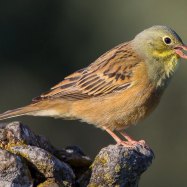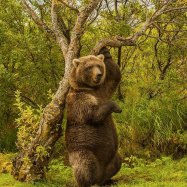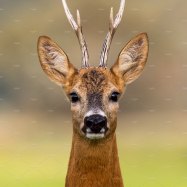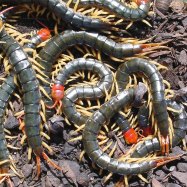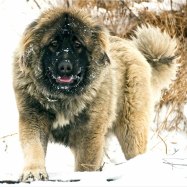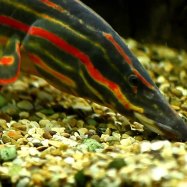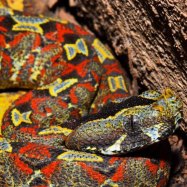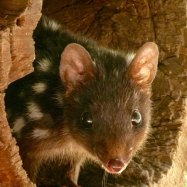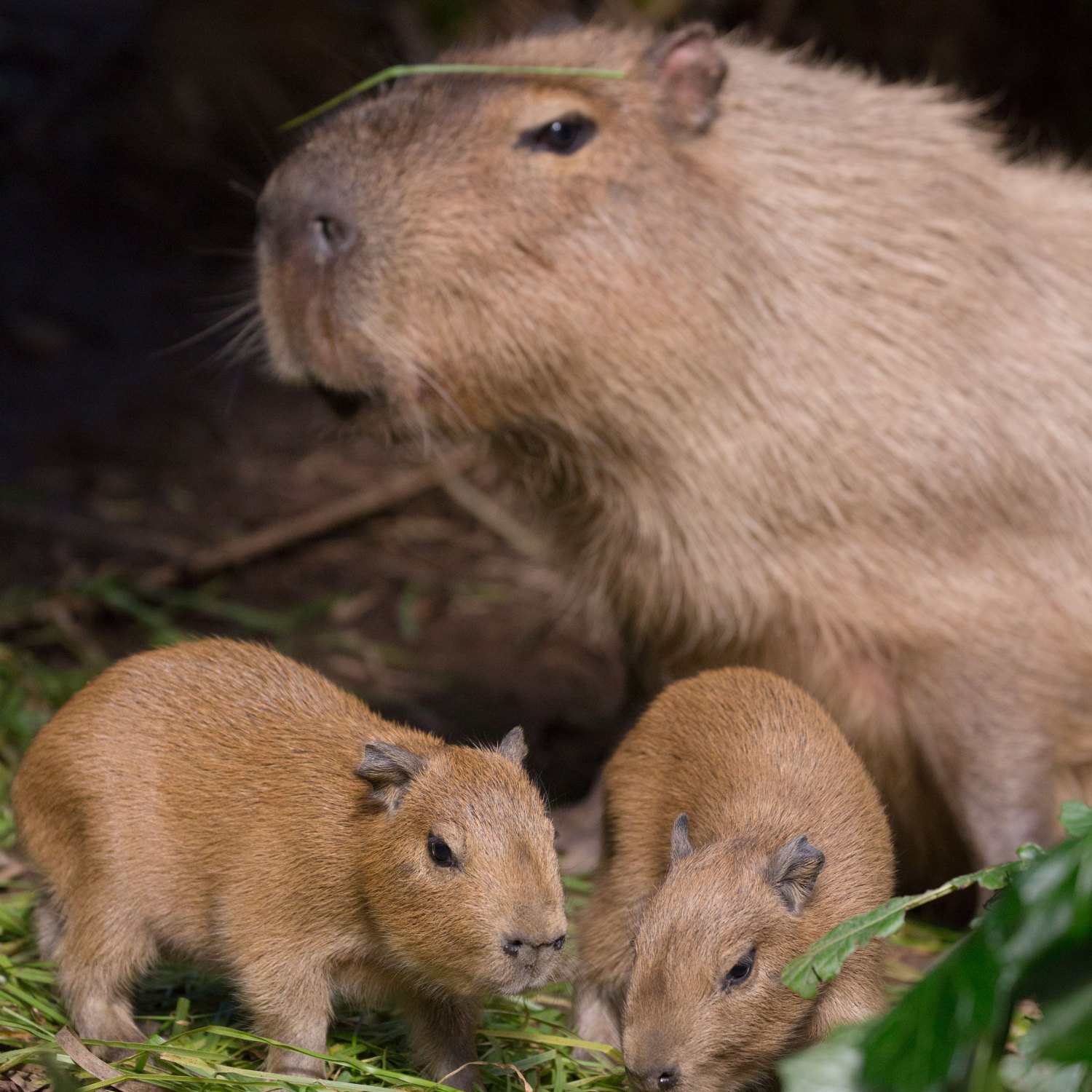
Capybara
1.2-1.5 meters
Did you know that the capybara, the largest rodent in the world, can grow up to 1.2-1.5 meters in length? They can be found in grassy areas near water bodies, and belong to the family Caviidae. These adorable creatures have a large and round body shape, making them a popular attraction for animal lovers. #Capybara #Caviidae #Rodent #LargestRodent #AnimalLovers
Animal Details Summary:
Common Name: Capybara
Kingdom: Animalia
Habitat: Semi-aquatic habitats
The Fascinating World of Capybaras: Nature's Giant Rodents
The animal kingdom is a diverse and wondrous place, filled with a variety of creatures both great and small. In the vast expanse of South America, there is a unique and fascinating mammal that stands out among the rest – the capybara.The capybara, known scientifically as Hydrochoerus hydrochaeris, is the largest living rodent in the world. These gentle giants are found in the semi-aquatic habitats of South America, particularly in Brazil, and are often referred to as the "water pigs" or "giant guinea pigs" of the continent Capybara. Let's dive deeper into the world of capybaras and uncover their fascinating features and behaviors that make them one of nature's most unique and intriguing creatures.
A Kingdom of Rodents
The capybara belongs to the Animalia kingdom, just like all other animals, and is classified under the phylum Chordata. Within Chordata, they belong to the class Mammalia, which includes all mammals such as humans, bears, and elephants. But what sets capybaras apart from other mammals is their order and family – Rodentia and Caviidae, respectively.With their large, sharp teeth for gnawing and long, hairless tails, it's clear that capybaras are indeed rodents. However, their size and unique features make them unlike any other rodent in the world.
A Semi-Aquatic Lifestyle
Capybaras are highly adapted to a semi-aquatic lifestyle, spending much of their time in and around water bodies. Their habitat includes marshes, rivers, and lakes, where they can swim and hide from predators. However, they also inhabit grassy areas near water, where they can graze on vegetation Cave Bear.Their semi-aquatic lifestyle is not only a matter of preference but also a necessity for their survival. Being herbivores, capybaras rely on a diet of various plants and grasses, which they can find in abundance near water bodies. This diet is particularly important for their digestion, as they have a unique fermentation process in their stomachs, similar to that of cows, which helps them break down tough plant fibers.
Geographical Distribution and Origin
South America is the only place in the world where you can find capybaras in the wild. They are widely distributed in countries such as Brazil, Colombia, Venezuela, Argentina, and Uruguay. However, Brazil is home to the largest population of capybaras, and it is believed that they originated from this country.Capybaras prefer living in warm and humid environments, making the tropical regions of South America an ideal habitat for them. They are often found in open grasslands, savannas, and forests near water, where they can find a perfect balance between food and shelter.
A Perfect Camouflage
One of the first things you may notice about capybaras is their brown fur, which helps them blend in with their surroundings. This coloration serves as a form of camouflage, allowing them to stay hidden from predators such as jaguars, pumas, and anacondas. In fact, capybaras are excellent swimmers, and when they sense danger, they can quickly dive into the water and swim away.However, it's not just their fur that helps them blend in. Their body shape is also an adaptation for survival. It's round and stout, making it easier for them to stay buoyant while swimming. This shape also allows them to easily maneuver through dense vegetation, which is essential for escaping predators.
The Giant of the Rodent World
When we think of rodents, we often imagine small, scurrying creatures like mice and rats. But capybaras are far from being small. In fact, they can grow up to 1.2-1.5 meters in length and weigh up to 66 kilograms, making them the largest living rodent in the world.Despite their size, capybaras are surprisingly agile and can run at speeds of up to 35 kilometers per hour. This incredible speed is another adaptation for survival, allowing them to quickly escape danger or catch up with their herd.
Life in the Herd
Capybaras are very social animals and live in herds, which can consist of up to 20 individuals. The herd usually includes one dominant male, several females, and their offspring. They are very protective of each other and work together to ensure the safety and well-being of their group.The herd also plays a significant role in the grooming and care of the young capybaras. Female capybaras give birth to litters of four to eight young, called pups, who can swim and walk as soon as they are born. The other members of the herd help to look after and groom the pups, ensuring their survival and bonding within the group.
An Essential Role in Ecosystems
Apart from being fascinating creatures, capybaras also play a crucial role in the ecosystems where they reside. As herbivores, they play a significant role in seed dispersal and nutrient cycling, which facilitates the growth and survival of various plant species. Their role as prey also provides a food source for many predators, maintaining a delicate balance in the food chain.The Human-Capybara Relationship
The relationship between humans and capybaras has a long history, dating back to ancient times when indigenous tribes used capybara meat for food and their fur for clothing. However, as human populations grew, capybaras became a target for hunters, leading to a decline in their population.Today, capybaras are legally protected in various countries, and their numbers are stable. In some areas, they are even considered a pest due to their large numbers, and culling programs are in place to control their population.
However, there are also efforts to conserve and protect capybaras and their habitats. In Brazil, there is a sustainable tourism industry that allows visitors to observe capybaras in their natural habitat, providing an economic incentive for local communities to protect these gentle giants.
In Conclusion
The capybara is truly a unique and incredible animal, with a rich and fascinating history. From their semi-aquatic lifestyle to their large size and role in ecosystems, there is so much to admire and learn from these gentle creatures. As we continue to uncover their mysteries, it's important that we also work towards protecting and preserving their habitats and populations, so future generations can also marvel at the wonder of nature's giant rodents.

Capybara
Animal Details Capybara - Scientific Name: Hydrochoerus hydrochaeris
- Category: Animals C
- Scientific Name: Hydrochoerus hydrochaeris
- Common Name: Capybara
- Kingdom: Animalia
- Phylum: Chordata
- Class: Mammalia
- Order: Rodentia
- Family: Caviidae
- Habitat: Semi-aquatic habitats
- Feeding Method: Herbivore
- Geographical Distribution: South America
- Country of Origin: Brazil
- Location: Grassy areas near water bodies
- Animal Coloration: Brown
- Body Shape: Large and round
- Length: 1.2-1.5 meters
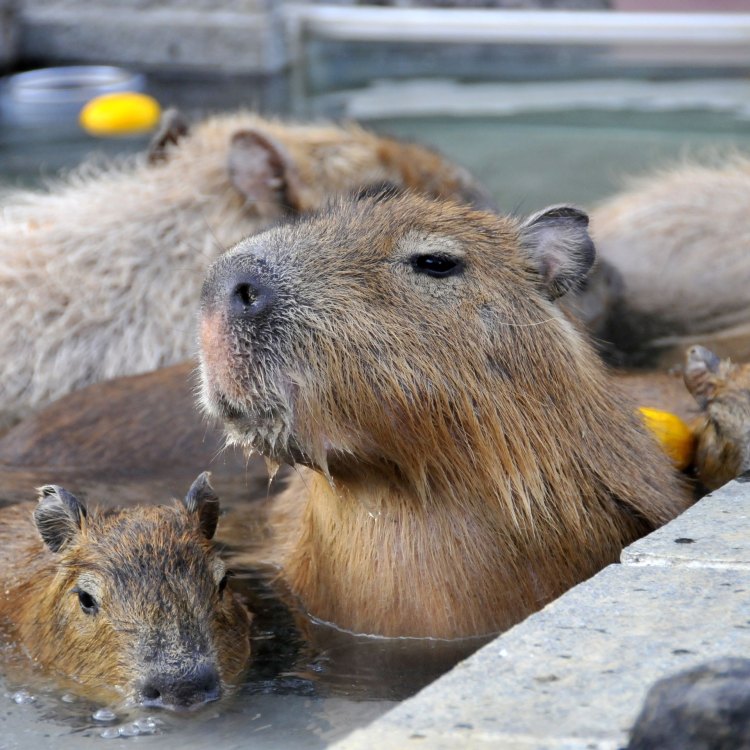
Capybara
- Adult Size: 40-70 kg
- Average Lifespan: 8-10 years
- Reproduction: Sexual
- Reproductive Behavior: Promiscuous
- Sound or Call: Variety of vocalizations
- Migration Pattern: Non-migratory
- Social Groups: Group living
- Behavior: Semi-aquatic and gregarious
- Threats: Hunting and habitat loss
- Conservation Status: Least Concern
- Impact on Ecosystem: Important in maintaining wetland ecosystems
- Human Use: Hunted for meat and fur
- Distinctive Features: Large size and webbed feet
- Interesting Facts: Capybaras are the largest rodents in the world
- Predator: Jaguars, caimans, and anacondas
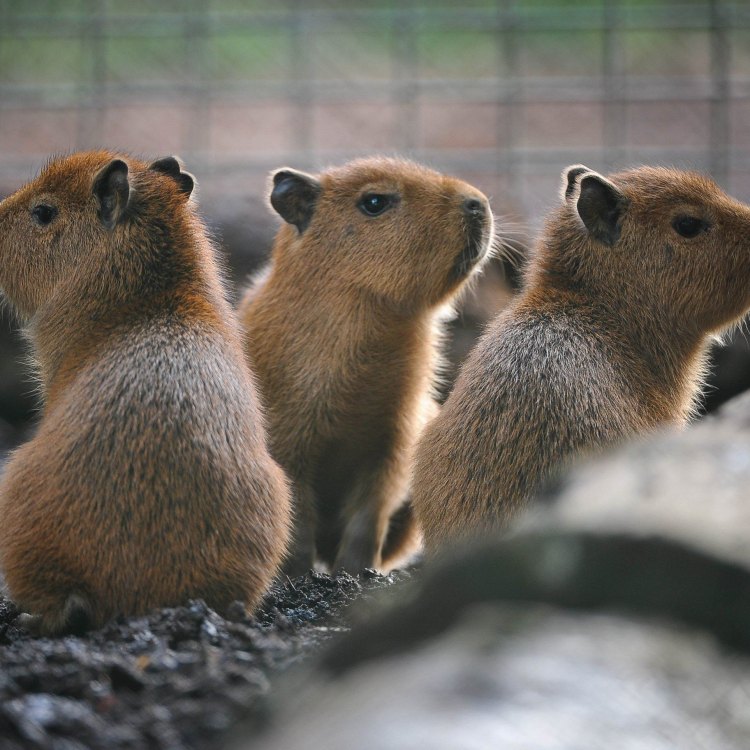
Hydrochoerus hydrochaeris
The Fascinating World of Capybaras: The Giant Rodents of South America
In the lush, dense forests of South America, there is a creature that roams its surroundings like a gentle giant. With its unique features and interesting behaviors, the capybara is an animal that captures the attention and curiosity of many. From being the largest rodents in the world to being important in maintaining wetland ecosystems, these creatures have a lot to offer. In this article, we will take a deep dive into the world of capybaras and discover what makes them so special PeaceOfAnimals.Com.Discovering the Capybara: Adult Size and Average Lifespan
Capybaras are part of the animal family called Caviidae, which includes guinea pigs and rock cavies. They are native to South America and can be found in countries such as Brazil, Venezuela, and Colombia. They are also the largest rodents in the world, with adults weighing between 40 to 70 kilograms and measuring up to 1.3 meters in length. This impressive size makes them quite a sight to behold and is one of their most distinctive features.Capybaras have a lifespan of 8 to 10 years in the wild, but they can live up to 12 years in captivity, with proper care and nutrition. Unlike most rodents, capybaras are not prolific breeders, which may explain their relatively short lifespan. Additionally, they are also prone to diseases such as fungal infections, parasitic infections, and respiratory infections in captivity, which can significantly impact their lifespan.
The Importance of Reproduction: Sexual and Promiscuous Behavior
Like most mammals, capybaras reproduce sexually, with males and females coming together for mating Cookiecutter Shark. However, what sets them apart is their promiscuous behavior. In capybara communities, it is not uncommon for males to mate with multiple females, and females may mate with multiple males.This behavior ensures genetic diversity within the population and helps prevent inbreeding, which can lead to genetic defects and health problems. Additionally, this behavior also allows for social bonds to form within the group, creating a sense of cohesion and cooperation.
The Sounds of Nature: Variety of Vocalizations
Capybaras may be the largest rodents in the world, but that does not mean they are quiet creatures. In fact, they are quite vocal, with a variety of vocalizations used for communication. These vocalizations range from whistles, clicks, barks, and purrs, each with its own meaning.For instance, a loud, high-pitched whistle usually means a warning of danger, while a softer, lower-pitched chirp is used to communicate with newborns. They even have a specific vocalization, called a bark, which they use to communicate with other capybaras who are outside their social group.
Staying Put: Non-migratory Migration Pattern
Capybaras are known for being semi-aquatic, and their habitats usually include bodies of water such as rivers, streams, and ponds. However, despite their love for water, they are non-migratory, meaning they do not embark on long-distance movements to find nesting or feeding areas.Instead, capybaras have a home range, where they spend most of their time, moving only short distances to find food or water sources. They are also highly territorial, with designated areas within their home range for different activities such as feeding, resting, and socializing.
Living in Harmony: Group Living and Social Behavior
Capybaras are gregarious animals, meaning they live in groups, and these groups can range from 10 to 20 individuals. When it comes to social structures, capybaras have a hierarchy, with dominant males and females leading the group. Young males leave the group when they reach sexual maturity, while females stay within the group for life.Living in a group has many benefits for capybaras, such as increased protection, sharing of resources, and cooperative care for young ones. This social behavior may also explain their promiscuous reproductive behavior, as it allows for a harmonious dynamic within the group.
Threats to Survival: Hunting and Habitat Loss
Unfortunately, capybaras face several threats to their survival, with hunting and habitat loss being the most significant. In some countries, capybaras are hunted for their meat, which is considered a delicacy, and their fur, which is used to make clothing and accessories.Additionally, the destruction of wetland habitats due to human activities such as farming, mining, and construction also poses a significant threat to capybaras. This loss of habitat not only affects capybaras but also has a ripple effect on the entire ecosystem.
The Race for Survival: Conservation Status and Impact on Ecosystem
Despite these threats, the capybara is currently listed as "Least Concern" on the International Union for Conservation of Nature (IUCN) Red List. This is due to their widespread distribution, large population size, and adaptability to different habitats.However, it is essential to note that capybaras play a crucial role in maintaining and regulating wetland ecosystems. As herbivores, they help control the growth of aquatic plants, which can cause imbalances in the ecosystem. Additionally, their feeding and nesting habits also contribute to the diversity of plant and animal species in their habitats.
Human Use: The Tragic End of a Gentle Giant
Sadly, despite their importance in the ecosystem, capybaras are still hunted for various reasons. In some countries, they are considered a nuisance due to their destructive feeding habits and may be killed to protect crops. In others, they are hunted for their valuable fur and meat, giving rise to an illegal trade.This human use of capybaras can have devastating effects. Not only does it affect the population of these animals, but it also disrupts the delicate balance of the ecosystem. With the loss of capybaras, the ecosystem can be thrown off-balance, affecting other plant and animal species.
Surviving the Threats: Unique Features and Interesting Facts
Despite the challenges they face, capybaras have managed to survive and thrive in their natural habitats. One of the main reasons for this is their unique features, such as their large size and webbed feet, which make them excellent swimmers and help them navigate through wetland habitats with ease.In addition to their unique features, capybaras also have several interesting facts that make them stand out. For instance, they are hindgut fermenters, which means they have a large cecum that helps them digest tough, fibrous plants. They can also hold their breath for up to five minutes underwater, making them excellent divers.
The Circle of Life: Predators of the Capybara
Just like any other animal, capybaras have natural predators in their environment. Some of their predators include jaguars, caimans, and even anacondas. These animals mainly prey on young capybaras, as adults are too large for them to take down.As an adaptation to this threat, capybaras have developed an interesting method of survival. When approached by a predator, they will emit a high-pitched alarm call, which alerts other capybaras in the group to retreat to the water for safety.
In Conclusion
Capybaras may not be the most well-known animals, but they have certainly made their mark in the animal kingdom. From their impressive size and unique features to their important role in the ecosystem, capybaras are truly fascinating creatures. It is our responsibility to ensure their survival and protect them from the threats they face, allowing us to continue admiring these gentle giants for years to come.
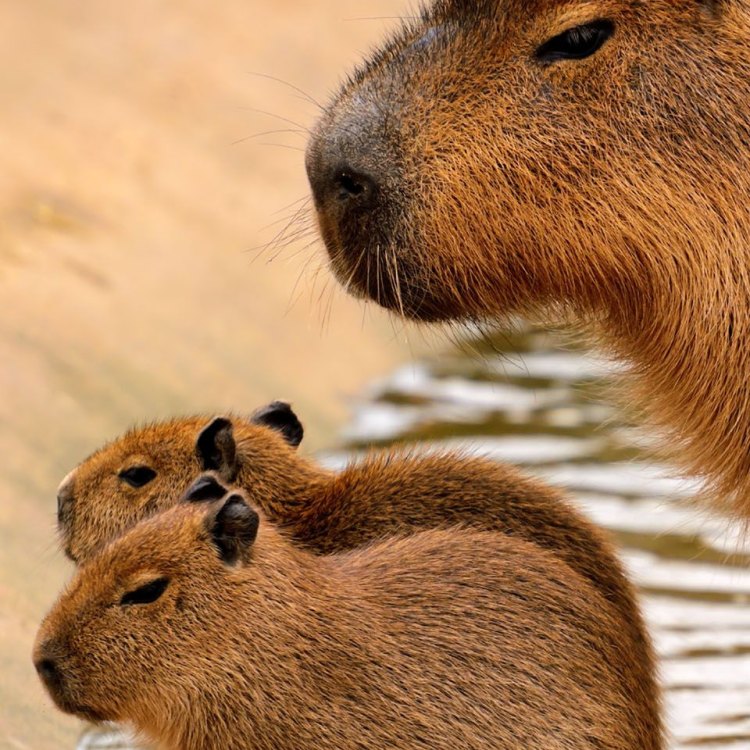
The Fascinating World of Capybaras: Nature's Giant Rodents
Disclaimer: The content provided is for informational purposes only. We cannot guarantee the accuracy of the information on this page 100%. All information provided here may change without prior notice.


